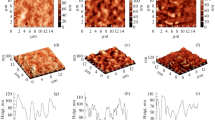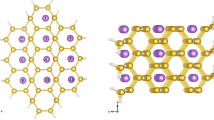Abstract
In this work, we address the effects of molecular doping on the electronic properties of fluorinated and chlorinated silicon nanowires (SiNWs), in comparison with those corresponding to hydrogen-passivated SiNWs. Adsorption of n-type dopant molecules on hydrogenated and halogenated SiNWs and their chemisorption energies, formation energies, and electronic band gap are studied by using density functional theory calculations. The results show that there are considerable charge transfers and strong covalent interactions between the dopant molecules and the SiNWs. Moreover, the results show that the energy band gap of SiNWs changes due to chemical surface doping and it can be further tuned by surface passivation. We conclude that a molecular based ex-situ doping, where molecules are adsorbed on the surface of the SiNW, can be an alternative path to conventional doping.

Molecular doping of halogenated silicon nanowires






Similar content being viewed by others
References
Rurali R (2010) Colloquium: Structural, electronic, and transport properties of silicon nanowires. Rev Mod Phys 82(1):427–449. https://doi.org/10.1103/RevModPhys.82.427
Kuo J-K, Huang P-H, Wu W-T, Lu C-M (2014) Mechanical and fracture behaviors of defective silicon nanowires: combined effects of vacancy clusters, temperature, wire size, and shape. Appl Phys A 114:1247–1256. https://doi.org/10.1007/s00339-013-7886-x
Huang P-H, Lu C-M (2014) Effects of vacancy cluster defects on electrical and thermodynamic properties of silicon crystals. Sci World J 2014(863404):1–8. https://doi.org/10.1155/2014/863404
Hever A, Bernstein J, Hod O (2013) Fluorination effects on the structural stability and electronic properties of sp3-type silicon nanotubes. J Phys Chem C 117(28):14684–14691. https://doi.org/10.1021/jp4045786
Miranda Á, Cruz–Irisson M, Pérez LA (2015) Controlling stability and electronic properties of small–diameter SiC nanowires by fluorination. Int J Nanotechnol 12(3–4):218–225. https://doi.org/10.1504/ijnt.2015.067207
Miranda A, Pérez LA (2016) Electronic properties of fluorinated silicon carbide nanowires. Comput Mater Sci 111:294–300. https://doi.org/10.1016/j.commatsci.2015.09.028
Salzmann I, Heimel G (2015) Toward a comprehensive understanding of molecular doping organic semiconductors (review). J Electron Spectrosc Relat Phenom 204(Part A):208–222. https://doi.org/10.1016/j.elspec.2015.05.001
Salzmann I, Heimel G, Oehzelt M, Winkler S, Koch N (2016) Molecular electrical doping of organic semiconductors: fundamental mechanisms and emerging dopant design rules. Acc Chem Res 49(3):370–378. https://doi.org/10.1021/acs.accounts.5b00438
Wehling TO, Morozov SV, Vdovin EE, Katsnelson MI, Geim AK, Lichtenstein AI (2008) Molecular doping of graphene. Nano Lett 8(1):173–177. https://doi.org/10.1021/nl072364w
Cai B, Zhang S, Yan Z, Zeng H (2015) Noncovalent molecular doping of two-dimensional materials. ChemNanoMat 1(8):542–557. https://doi.org/10.1002/cnma.201500102
Srivastava PK, Yadav P, Rani V, Ghosh S (2017) Controlled doping in graphene monolayers by trapping organic molecules at the graphene–substrate interface. ACS Appl Mater Interfaces 9(6):5375–5381. https://doi.org/10.1021/acsami.6b13211
Mortazavi Zanjani SM, Sadeghi MM, Holt M, Chowdhury SF, Tao L, Akinwande D (2016) Enhanced sensitivity of graphene ammonia gas sensors using molecular doping. Appl Phys Lett 108(3):033106. https://doi.org/10.1063/1.4940128
Lancellotti L, Bobeico E, Capasso A, Lago E, Delli Veneri P, Leoni E, Buonocore F, Lisi N (2016) Combined effect of double antireflection coating and reversible molecular doping on performance of few-layer graphene/n-silicon Schottky barrier solar cells. Sol Energy 127:198–205. https://doi.org/10.1016/j.solener.2016.01.036
Zhang J, Emelianov AV, Bakulin AA Bobrinetskiy II (2016) Molecular doping of single-walled carbon nanotube transistors: optoelectronic study. In: Physical chemistry of interfaces and nanomaterials XV. Proc. SPIE, p 992319. https://doi.org/10.1117/12.2236987
Geier ML, Moudgil K, Barlow S, Marder SR, Hersam MC (2016) Controlled n-type doping of carbon nanotube transistors by an organorhodium dimer. Nano Lett 16(7):4329–4334. https://doi.org/10.1021/acs.nanolett.6b01393
Caccamo S, Puglisi RA, Di Franco S, D’Urso L, Indelicato V, Italia M, Pannitteri S, La Magna A (2016) Silicon doped by molecular doping technique: role of the surface layers of doped Si on the electrical characteristics. Mater Sci Semicond Process 42(Part 2):200–203. https://doi.org/10.1016/j.mssp.2015.08.017
Edmonds MT, Hellerstedt J, O’Donnell KM, Tadich A, Fuhrer MS (2016) Molecular doping the topological dirac semimetal Na3Bi across the charge neutrality point with F4-TCNQ. ACS Appl Mater Interfaces 8(25):16412–16418. https://doi.org/10.1021/acsami.6b03312
Jing Y, Tan X, Zhou Z, Shen P (2014) Tuning electronic and optical properties of MoS2 monolayer via molecular charge transfer. J Mater Chem A 2(40):16892–16897. https://doi.org/10.1039/C4TA03660C
Du Y, Liu H, Neal AT, Si M, Ye PD (2013) Molecular doping of multilayer MoS2 field-effect transistors: reduction in sheet and contact resistances. IEEE Electron Device Lett 34(10):1328–1330. https://doi.org/10.1109/LED.2013.2277311
Lockhart De La Rosa CJ, Phillipson R, Teyssandier J, Adisoejoso J, Balaji Y, Huyghebaert C, Radu I, Heyns M, De Feyter S, De Gendt S (2016) Molecular doping of MoS2 transistors by self-assembled oleylamine networks. Appl Phys Lett 109(25):253112. https://doi.org/10.1063/1.4972781
Zhang Y, Wang Y, Sun Z, Li F, Tao R, Jin Z, Xu L (2017) Large grain growth for hole-conductor-free fully printable perovskite solar cells via polyoxometalate molecular doping. Chem Commun 53(14):2290–2293. https://doi.org/10.1039/C6CC08516D
Jing Y, Tang Q, He P, Zhou Z, Shen P (2015) Small molecules make big differences: molecular doping effects on electronic and optical properties of phosphorene. Nanotechnology 26(9):095201. https://doi.org/10.1088/0957-4484/26/9/095201
Luo L-B, Yang X-B, Liang F-X, Jie J-S, Wu C-Y, Wang L, Yu Y-Q, Zhu Z-F (2011) Surface dangling bond-mediated molecules doping of germanium nanowires. J Phys Chem C 115(49):24293–24299. https://doi.org/10.1021/jp208708e
Amato G, Cultrera A, Boarino L, Lamberti C, Bordiga S, Mercuri F, Cartoixà X, Rurali R (2013) Molecular doping and gas sensing in Si nanowires: from charge injection to reduced dielectric mismatch. J Appl Phys 114(20):204302. https://doi.org/10.1063/1.4834576
Puglisi RA, Garozzo C, Bongiorno C, Di Franco S, Italia M, Mannino G, Scalese S, La Magna A (2015) Molecular doping applied to Si nanowires array based solar cells. Sol Energy Mater Sol Cells 132:118–122. https://doi.org/10.1016/j.solmat.2014.08.040
Koren E, Rosenwaks Y, Allen JE, Hemesath ER, Lauhon LJ (2009) Nonuniform doping distribution along silicon nanowires measured by Kelvin probe force microscopy and scanning photocurrent microscopy. Appl Phys Lett 95(9):092105. https://doi.org/10.1063/1.3207887
Dayeh SA, Chen R, Ro YG, Sim J (2017) Progress in doping semiconductor nanowires during growth. Mater Sci Semicond Process 62:135–155. https://doi.org/10.1016/j.mssp.2016.10.016
Zhang X, Gong X (2015) DFT, QTAIM, and NBO investigations of the ability of the Fe or Ni doped CNT to absorb and sense CO and NO. J Mol Model 21(9):225. https://doi.org/10.1007/s00894-015-2778-y
Miranda-Durán Á, Cartoixà X, Cruz Irisson M, Rurali R (2010) Molecular doping and subsurface dopant reactivation in Si nanowires. Nano Lett 10(9):3590–3595. https://doi.org/10.1021/nl101894q
Miranda Á, Cartoixà X, Canadell E, Rurali R (2012) NH3 molecular doping of silicon nanowires grown along the [112], [110], [001], and [111] orientations. Nanoscale Res Lett 7(1):308. https://doi.org/10.1186/1556-276x-7-308
Leu PW, Shan B, Cho K (2006) Surface chemical control of the electronic structure of silicon nanowires: density functional calculations. Phys Rev B 73(19):195320. https://doi.org/10.1103/PhysRevB.73.195320
Jeppesen JO, Becher J (2003) Pyrrolo-tetrathiafulvalenes and their applications in molecular and supramolecular chemistry. Eur J Org Chem 2003(17):3245–3266. https://doi.org/10.1002/ejoc.200300078
Denhof A, Cordes J, Azov VA (2011) Synthesis of novel highly soluble N-(3,5-Di-tert-butylbenzyl)-monopyrrolo-tetrathiafulvalene derivatives. Phosphorus Sulfur Silicon Relat Elem 186(5):1278–1283. https://doi.org/10.1080/10426507.2010.524175
Perdew JP, Burke K, Ernzerhof M (1996) Generalized gradient approximation made simple. Phys Rev Lett 77(18):3865–3868. https://doi.org/10.1103/PhysRevLett.77.3865
Soler JM, Artacho E, Gale JD, García A, Junquera J, Ordejón P, Sánchez-Portal D (2002) The SIESTA method for ab initio order- N materials simulation. J Phys Condens Matter 14(11):2745. https://doi.org/10.1088/0953-8984/14/11/302
Monkhorst HJ, Pack JD (1976) Special points for Brillouin-zone integrations. Phys Rev B 13(12):5188–5192. https://doi.org/10.1103/PhysRevB.13.5188
Troullier N, Martins JL (1991) Efficient pseudopotentials for plane-wave calculations. Phys Rev B 43(3):1993–2006. https://doi.org/10.1103/PhysRevB.43.1993
Fonseca Guerra C, Handgraaf J-W, Baerends EJ, Bickelhaupt FM (2004) Voronoi deformation density (VDD) charges: assessment of the Mulliken, Bader, Hirshfeld, Weinhold, and VDD methods for charge analysis. J Comput Chem 25(2):189–210. https://doi.org/10.1002/jcc.10351
Miranda A, de Santiago F, Pérez LA, Cruz-Irisson M (2017) Silicon nanowires as potential gas sensors: a density functional study. Sensors Actuators B Chem 242:1246–1250. https://doi.org/10.1016/j.snb.2016.09.085
Acknowledgments
This work was partially supported by individual project IPN-SIP-2017-0885, multidisciplinary projects IPN-SIP 2016-1770, 2016-1771, and UNAM-DGAPA-PAPIIT IN107717. L.A.P. acknowledges partial support from “Cátedra Marcos Moshinsky” and PIIF-UNAM No. 03. Computations were performed at Miztli of DGTIC-UNAM (project LANCAD-UNAM-DGTIC-180), F.S. would like to thank the CONACYT and BEIFI-Instituto Politécnico Nacional for their scholarships.
Author information
Authors and Affiliations
Corresponding author
Additional information
This paper belongs to Topical Collection QUITEL 2016
Rights and permissions
About this article
Cite this article
de Santiago, F., Trejo, A., Miranda, A. et al. Band-gap engineering of halogenated silicon nanowires through molecular doping. J Mol Model 23, 314 (2017). https://doi.org/10.1007/s00894-017-3484-8
Received:
Accepted:
Published:
DOI: https://doi.org/10.1007/s00894-017-3484-8




